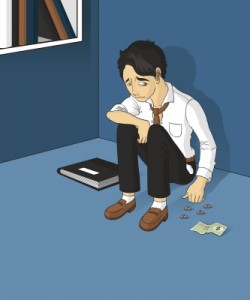While listening to the news on the radio, it was announced that in Pennsylvania 1 in every 5 children lives below the  poverty level. I’m sure this number varies from one state to the next but I thought it to be a rather scary statistic. This lesson and the included activities has students learning about poverty, what causes it, and an engaging simulation to see how easy it could be for some to live in poverty no matter how hard they try to avoid it.
poverty level. I’m sure this number varies from one state to the next but I thought it to be a rather scary statistic. This lesson and the included activities has students learning about poverty, what causes it, and an engaging simulation to see how easy it could be for some to live in poverty no matter how hard they try to avoid it.
Set
- What do you think of when you think of the word POVERTY? Write down as many things as you can that you associate with it. Whip around the room asking students to share their ideas and write them on the board.
Materials
- Projector & Screen
- Laptops
Activities
Ask students the following questions to get a feel for their knowledge on poverty and tie to their intro responses:
- What does poverty look like in America? Poverty looks like anyone who lacks sufficient money or goods to meet basic human needs such as food, shelter, clothing
- Who lives in poverty? Adults, teens, children…48 million living below the poverty level
- Where do we see poverty? Everywhere….It’s a worldwide epidemic…let’s look at our state. Complete the “What do you think?” activity first. Then go over actual PA stats. You can find all states information at this website.
- How do people end up living in poverty? A number of ways/reasons…View and write down as many reasons as you can think of.
- Answers may include:
- Education Level such as secondary and post-secondary degrees often determines type of job you have qualifications for as does experience in the field, lack specific skills.
- Family Structure can play a role too especially if you are a single parent, or a one income family, number of children.
- Geographical Location often determines cost of living, taxes, affordable housing, or number of industry or jobs in area. Rural vs. urban vs. city.
- Unemployment due to loss of job from down-sizing, closures, furloughs, etc. Many have stopped looking/applying because they can’t find anything.
- Never Ending Cycle for some means they were born into poverty and do not have the means to escape.
- Answers may include:
- Can you be employed and still be living at the poverty level? Absolutely! A list of YouTube Clips to choose from to illustrate this can be found in the lesson below. Choose one or several to show your class.
- Ask students if they think it’s easy to budget a paycheck and meet all of your weekly/monthly expenses?
- Ask them to generate a list of all possible expenses and write them on the board (this will vary based on the specifics of each family): food, toiletries, housing, utilities, health care, medical/prescriptions, transportation, child care, clothing, laundry, taxes, insurance, household items, education, miscellaneous things like internet, cable, phones/cell plans, subscriptions, pets, emergencies.
- Have them turn to their neighbor and decide which of the above expenses are truly essential and necessary and which are non-essential extras. Have each group share and try to come to a class consensus. Was it easy to decide? What criteria did you use to determine each?
- Participate in the online simulation/game about surviving poverty and homelessness. It is called SPENT You can find an overview of the game here. After playing, students are to answer some follow-up questions about their experience. See lesson plan below.
- Finally, students will create a Non-Fiction Wikipedia Article to inform others about the Poverty Crisis affecting many families today using this free digital template from TPT. See guide sheet for criteria.
Attachments
- Living in Poverty Lesson (PDF)
- What Do You Think (PDF)
- NonFiction Wikipedia Article (PDF)
Resources
Similar Lesson
Image courtesy of David Castillo Dominici at Free Digital Photos


1 comment for “Living in Poverty Lesson & Activities”